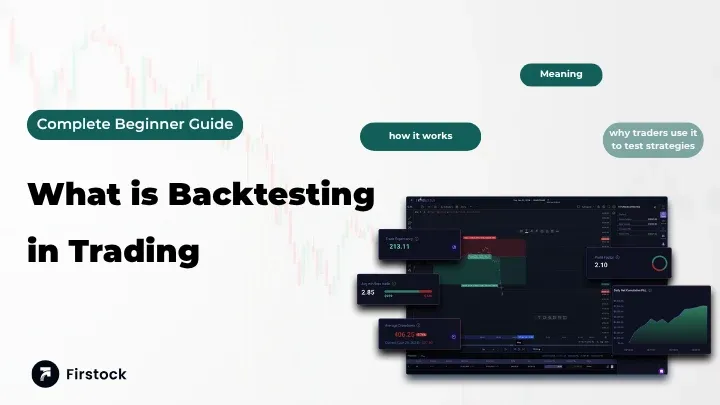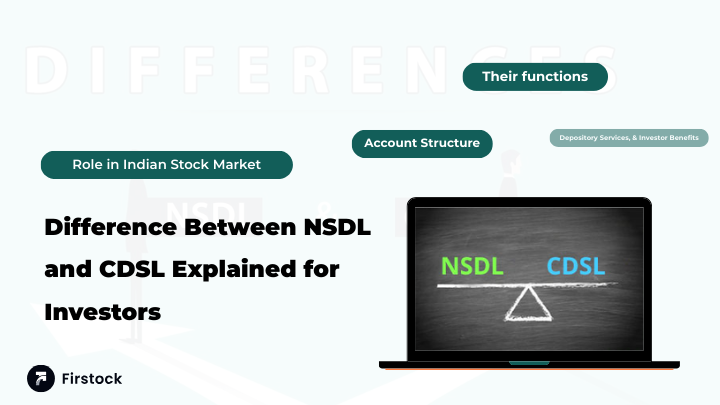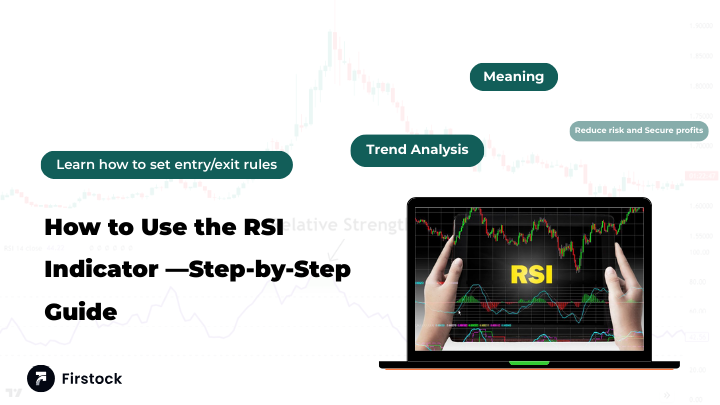What is Backtesting in Trading | Complete Beginner Guide

What Is Backtesting in Trading?
Before jumping into fancy tools or results, let’s start simple: what is backtesting in trading?Backtesting is basically the process of checking how well your trading model would have worked for past market data.
It is almost like a “time machine” for the traders where one can apply his/her present-day method to old market conditions and take a peek at the performance.
For instance: Imagine the scenario where you have created a system that operates on the basis of set rules — “Buy whenever the 50-day moving average goes over the 200-day average, and sell when it goes under.”
Backtesting will enable you to check out the performance of this particular regimen over the last 5 or 10 years.
Did it provide regular returns? Did it experience a downfall during the unstable markets? Was there any trend formed?You are then allowed to make decisions that are supported by facts rather than relying on your gut feelings.
What Makes Backtesting Of Trading Strategies So Vital
Basically, it’s a fact that trading is largely an emotional game.The feeling of fear and greed, among other things, is what you get when both the upward spike and the downward fall of the market occur almost at the same time. However, backtesting trading strategies ensures that trading is done with confidence and logic rather than the typical emotional guesswork.
Following are the reasons why backtesting is important:
Put simply — if you wouldn’t drive a car without testing the brakes, you shouldn’t trade a strategy without backtesting it first.
The Core Components of Backtesting
Good backtesting in trading isn’t just about running a formula — it’s about replicating real-world trading conditions as accurately as possible. Here’s what goes into an effective backtest:
1. A Clear Trading Strategy
Besides the rules for entry and exit, you also need a culture that is precise in its content and conduct.
Suppose: Entry: Buy when RSI drops below 30 and then reverses its direction. Exit: Sell when RSI goes beyond 70.
Statements with vague trading concepts like “buy when the trend seems bullish” don’t make sense in backtesting. The subject is not about one's gut feeling but exactness.
2. Reliable Historical Data
GIGO (Garbage In, Garbage Out) is the Star Rule here. Correct, top-notch historical data of price, volume, and volatility must be your standard. The farther and more wholesome your database, the better the results will be.
Several traders avail themselves of such platforms as TradingView, MetaTrader, or Amibroker to serve this purpose.
3. Performance Metrics
Backtesting needs to indicate:
- Success rate (% of profitable trades)
- Average gain per trade
- Maximum drawdown (deepest losing streak)
- Sharpe ratio (risk-adjusted returns)
- Profit factor (gross profit ÷ gross loss)
Such metrics empower you to match strategies on a rational basis.
4. Risk and Position Sizing
Even the most profitable strategy is doomed if you put too much at risk on each trade. Make sure you have good risk management incorporated in your trading plan, for instance, you might be risking only 1–2% of your total capital per trade to be more in line with the outcomes you want to see.
5. Transaction Costs and Slippage
Forget fees, spreads, and slippage at your peril. Although they may look insignificant, they can accumulate over hundreds of trades — which is the main reason why what looks like a winning system from the outset may end up in red.
How to Perform Backtesting in Trading (Step-by-Step)
Remember what we discussed above, and let's proceed to the demonstration of backtesting trading strategies.
Step 1: Define Your Strategy Just to make sure:
- Which indicators you will apply? (e.g. RSI, MACD, moving averages)
- Period (Intraday, daily, weekly)
- Signals of entry and exit from the market
- Stop-loss and take-profit regulations
Example: Use the moving average (MA) of 50 days to cross over the 200 days' MA, to buy. Use the 50-day MA to cross under the 200-day MA and thereby, appoint sell signal.
Step 2: Gather Historical Data Find and download the most accurate market data for your trading instrument (stocks, options, or indices). Such platforms as TradingView, Yahoo Finance, or QuantConnect provide valuable data sets.
Step 3: Run the Backtest Open your favorite software (even Excel for basic scenarios) and proceed with the backtesting. Input the trading rules into the system which is programmed to simulate trading with historical data.
Step 4: Analyze the Results Once the backtest is done, you will have access to detailed reports — profit/loss charts, measures, and trade logs. Some questions to guide you:
- Was it profitable in general?
- What was the largest drawdown?
- How often did it lose money?
- Does it perform better in trending or sideways markets?
Step 5: Optimize (But Don’t Overfit!) You might be tempted to tweak every setting until your backtest looks perfect — resist that urge! That’s called overfitting, and it can make your strategy look good on paper but fail in live markets. Instead, focus on robustness — a strategy that performs consistently well, not perfectly once.
Step 6: Forward Testing Once your backtest looks promising, test it in real-time with paper trading. This step helps confirm if the strategy performs well under current conditions — not just past data.
Backtesting Strategies in Action: A Simple Example
Let’s illustrate with a classic trend-following system: Strategy: Buy when the 20-day EMA crosses above the 50-day EMA. Sell when the 20-day EMA crosses below the 50-day EMA.
Backtest Period: 2015–2025 Asset: Nifty 50
Results:
- Total trades: 48
- Win rate: 58%
- CAGR (annual return): 13.2%
- Max drawdown: –12.8%
Would you trade it live? Maybe — but you’d also check how it performs in different market phases (bull, bear, sideways) to ensure stability. This is the beauty of backtesting strategies — you get clarity before risking capital.
Options Backtesting — A Special Case
Backtesting becomes even more crucial — and tricky — when it comes to options backtesting. Options have time decay (Theta), volatility (Vega), and complex payoffs that make simple historical price analysis insufficient.
Here’s how traders approach options backtesting effectively:
- Use options-specific data — including implied volatility, strike prices, and expiry dates.
- Backtest strategies like covered calls, iron condors, or straddles on historical options chains.
- Track Greeks (Delta, Theta, Vega) to understand how changes in volatility and time impact your trades.
Platforms like Sensibull, OptionStrat, or QuantInsti’s Blueshift make this easier. Remember, while backtesting in trading gives insights, options backtesting adds a layer of depth — because it simulates real-world complexity much more closely.
Common Mistakes to Avoid in Backtesting Trading Strategies
Backtesting can make you feel powerful — but it can also mislead you if done carelessly. Here are some common pitfalls to watch out for:
- Overfitting As mentioned earlier, tweaking parameters until results look “perfect” is dangerous. Markets change — your backtest shouldn’t rely on one perfect setup.
- Ignoring Costs Many traders skip including transaction fees, brokerage, or slippage. In real life, these can eat into 10–30% of profits.
- Look-Ahead Bias If your strategy accidentally uses future data (like using the day’s close for same-day entries), your results will be unrealistically good.
- Small Sample Size Testing a strategy on just a few trades or a short time period is meaningless. Always backtest over multiple years and market conditions.
- Emotional Bias Traders often discard results that don’t “feel right.” But numbers don’t lie — trust the data, not your ego.
Manual vs Automated Backtesting
There are two main approaches to backtesting trading strategies — each with its pros and cons.
For most traders, a mix of both works best — start manually to understand the logic, then automate once you’re confident.
The Role of Psychology in Backtesting
Here’s an interesting twist — backtesting strategies isn’t just about math and data. It’s also about mindset. Why? Because even a strong backtest won’t save you if you don’t have the discipline to follow it in real time.
Backtesting helps build trust in your strategy. When you’ve seen it survive market crashes, you’ll stay calm during future volatility. It’s like training your emotional muscle — every backtest you run strengthens your conviction.
Final Thoughts: Why Every Trader Needs Backtesting
At its core, backtesting trading strategies is about learning from the past to trade smarter in the future.You wouldn’t launch a rocket without simulations — so why risk your hard-earned capital without testing your trading ideas first?
When done right, backtesting in trading offers:Confidence in your systemClarity on performanceControl over riskConsistency over time
And remember — it’s not about finding the perfect strategy. It’s about finding a reliable one that fits your goals, risk appetite, and psychology.
So the next time you build a new strategy or tweak an old one, don’t ask, “Will this make me rich tomorrow?” Instead, ask — “Has this worked before, and can I trust it to work again?”
That’s the mindset of a professional trader — one who knows that backtesting trading strategies isn’t just a tool… it’s your edge.
FAQs
1. What is backtesting in trading and why is it important?
Backtesting in trading refers to a process in which a trading strategy is tested on past market data to assess the results it would have generated. It is a crucial step as it gives traders insight into whether their plan can work or not before they invest real money.
2. How do I start backtesting a trading strategy?
Essentially, you need to lay out specific rule-driven trades, collect indeed proper market data and use an instrument to carry out back test activity, for example, TradingView or MetaTrader. Thereafter you may interpret the conduct to build up your trading approach.
3. Is backtesting 100% reliable?
No, not entirely. The markets are always changing. Backtesting is a valuable tool for exposing the pros and cons of trading strategies, but real-time testing and an agile approach remain essential for survival in the long run.
4. What is options backtesting?
Backtesting of options pertains to the reins of option-rich strategies like covered calls or iron condors by way of historical options data comprising factors such as volatility and time decay.
5. Can beginners do backtesting?
Indeed so! Even a rudimentary Excel format or a demo account may assist newbies in comprehending what is backtesting in trading and how their strategy evolves over time.





